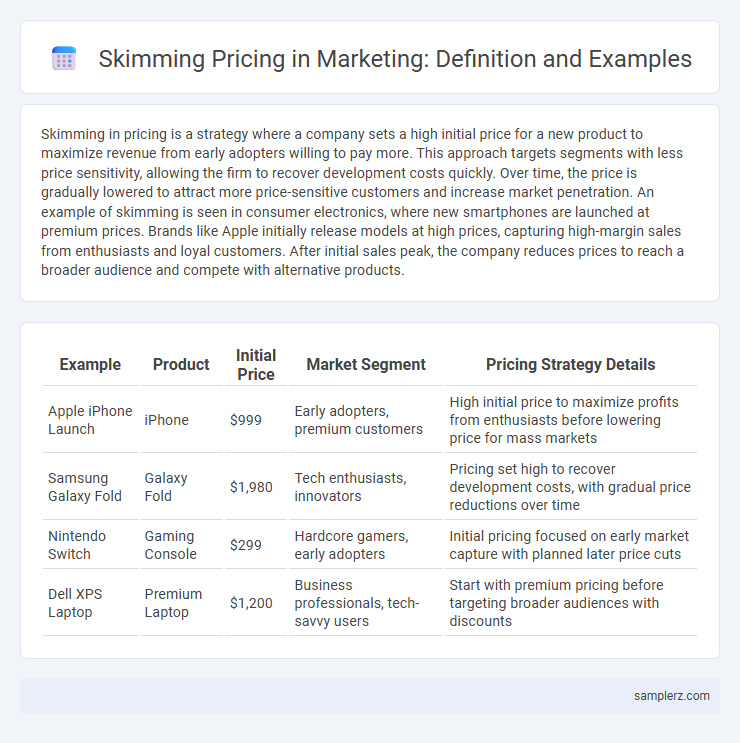Skimming in pricing is a strategy where a company sets a high initial price for a new product to maximize revenue from early adopters willing to pay more. This approach targets segments with less price sensitivity, allowing the firm to recover development costs quickly. Over time, the price is gradually lowered to attract more price-sensitive customers and increase market penetration. An example of skimming is seen in consumer electronics, where new smartphones are launched at premium prices. Brands like Apple initially release models at high prices, capturing high-margin sales from enthusiasts and loyal customers. After initial sales peak, the company reduces prices to reach a broader audience and compete with alternative products.
Table of Comparison
| Example | Product | Initial Price | Market Segment | Pricing Strategy Details |
|---|---|---|---|---|
| Apple iPhone Launch | iPhone | $999 | Early adopters, premium customers | High initial price to maximize profits from enthusiasts before lowering price for mass markets |
| Samsung Galaxy Fold | Galaxy Fold | $1,980 | Tech enthusiasts, innovators | Pricing set high to recover development costs, with gradual price reductions over time |
| Nintendo Switch | Gaming Console | $299 | Hardcore gamers, early adopters | Initial pricing focused on early market capture with planned later price cuts |
| Dell XPS Laptop | Premium Laptop | $1,200 | Business professionals, tech-savvy users | Start with premium pricing before targeting broader audiences with discounts |
Understanding Skimming Pricing Strategy
Skimming pricing strategy involves setting a high initial price for a new or innovative product to maximize early revenue from customers willing to pay a premium. As demand from this segment slows, the price is gradually lowered to attract more price-sensitive consumers. This approach is often used in technology markets to quickly recoup development costs and capitalize on early adopters.
Key Features of Price Skimming
Price skimming involves setting a high initial price for a new or innovative product to maximize early revenue from customers willing to pay a premium. Key features include targeting early adopters, recovering research and development costs quickly, and gradually lowering prices to attract more price-sensitive segments. This strategy is commonly used for technology products with strong brand differentiation and limited competition at launch.
Skimming in the Tech Industry: Real-World Examples
Tech companies often implement price skimming by launching innovative products at high initial prices to maximize profits from early adopters before gradually lowering prices. For instance, Apple introduced the first iPhones at premium prices targeting tech enthusiasts willing to pay more for cutting-edge features. Similarly, Samsung employed skimming with its Galaxy Fold series, setting high prices to capture early market demand and recoup development costs.
Case Study: Apple’s iPhone Skimming Approach
Apple's iPhone skimming approach involves launching new models at premium prices to target early adopters willing to pay more for innovative features and cutting-edge technology. This strategy maximizes revenue by capturing high consumer surplus before gradually lowering prices to attract more price-sensitive segments. Apple's pricing effectively leverages brand loyalty and perceived value, establishing market dominance while maintaining strong profit margins.
Price Skimming in the Fashion Sector
Price skimming in the fashion sector involves launching high-end designer apparel at premium prices to target early adopters and fashion enthusiasts willing to pay more for exclusivity. Brands like Gucci and Louis Vuitton implement this strategy by introducing limited-edition collections with elevated price points before gradually lowering prices for broader market segments. This approach maximizes initial revenue and reinforces brand prestige while capturing diverse consumer groups over time.
How Automakers Use Skimming for New Releases
Automakers implement price skimming by launching new vehicle models at premium prices to capture early adopters and maximize profits before gradually lowering prices to attract a broader market. This strategy leverages the high demand and limited initial supply of cutting-edge features, such as advanced electric powertrains or autonomous driving technology. Skimming also helps manufacturers recoup research and development costs while differentiating their products in a competitive automotive market.
Successful Skimming in the Gaming Market
The gaming market demonstrates successful skimming pricing with flagship consoles like the PlayStation 5, initially launched at a premium price point to capture early adopters willing to pay more for cutting-edge technology. This strategy maximizes revenue by targeting segments less sensitive to price before gradually lowering costs to attract a broader audience. Such pricing techniques enable companies to recuperate development investments and maintain profitability throughout the product lifecycle.
Media and Entertainment: Launching with Skimming Prices
Media and Entertainment companies often implement skimming pricing strategies by launching new movies, games, or streaming services at premium prices to maximize early revenue from enthusiastic audiences. For instance, blockbuster movie premieres or exclusive game releases are priced higher initially to capture the willingness-to-pay of fans before gradually reducing prices to attract a broader market. This approach leverages early adopter demand and media buzz to optimize profitability during the product's initial lifecycle phase.
Advantages and Challenges of Price Skimming
Price skimming allows businesses to maximize initial profits by targeting early adopters willing to pay premium prices for innovative products, enhancing revenue streams and recovering development costs quickly. This strategy creates a perception of high value and exclusivity, which can strengthen brand prestige and attract loyal customers. However, challenges include potential customer alienation due to high prices, rapid competitor entry who may undercut prices, and the risk of slowing volume sales as prices decrease over time.
Lessons Learned from Price Skimming Examples
Price skimming, exemplified by Apple's initial iPhone pricing strategy, demonstrates the effectiveness of targeting early adopters willing to pay a premium before gradually lowering prices to capture price-sensitive segments. Lessons learned include the importance of strong brand positioning and product differentiation to justify high initial prices without alienating future customers. Companies must carefully time price reductions to sustain demand while maximizing profit margins throughout the product lifecycle.

example of skimming in pricing Infographic
 samplerz.com
samplerz.com